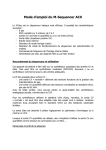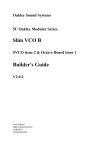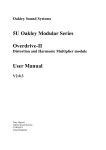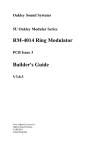Download SVCO-A & SVCO-B User Manual
Transcript
Oakley Sound Systems 5U Oakley Modular Series Slim VCO A & Slim VCO B Main PCB Issue 1, 1.1 & 2 User Manual V2.0.1 Tony Allgood Oakley Sound Systems CARLISLE United Kingdom The suggested panel design for the SVCO A in standard MOTM format. 2 The suggested panel design for the SVCO B in standard MOTM format. 3 Introduction This is the User Manual for both the A and B versions of the Slim Voltage Controlled Oscillator 5U module from Oakley Sound. This document contains an overview of the operation of the units and the calibration procedure. For the Builder's Guides, which contain a basic introduction to the board or boards, a full parts list for the components needed to populate the board or boards, and a list of the various interconnections, please visit the main project webpage at: http://www.oakleysound.com/s-vco.htm For general information regarding where to get parts and suggested part numbers please see our useful Parts Guide at the project webpage or http://www.oakleysound.com/parts.pdf. For general information on how to build our modules, including circuit board population, mounting front panel components and making up board interconnects please see our generic Construction Guide at the project webpage or http://www.oakleysound.com/construct.pdf. This is the prototype issue 1 Oakley SVCO-A module behind a natural finish 1U wide MOTM format Schaeffer panel. 4 The Oakley SVCO-A and SVCO-B Two compact well specified audio VCOs for MOTM and MU based modular synthesisers. The 'A' variant has a single tune control and three way octave switch. While the otherwise identical 'B' variant has an increment-decrement switching system (with three way momentary switch and LED ladder display) to allow for easy control over five octaves and a wide range LFO setting. SVCO-A modules are built with just the SVCO main board. The B variant uses the same SVCO main board with an additional SVCO-B daughter board that attaches to the main board via a tidy 10-way ribbon cable. Pitch is controlled by either a precision 1V/octave input socket or by a CV (control voltage) input whose sensitivity is controlled by a front panel pot. The SVCO can also be connected to the Oakley Buss for hassle free keyboard or sequencer control. Both variants have a variable width pulse wave as well as a sawtooth waveshaper to generate a fully varying shape from ramp through triangle to sawtooth. An external CV input may be used to control the waveshape. The Shape CV input features a reversible attenuator control so that the incoming CV may be inverted as well as simply level controlled. The SVCO uses a sawtooth core but with a different topology than our existing double width VCO. The core of the VCO circuit is based on designs used in a series of classic Japanese synthesisers from the mid to late 1970s. However, it should be said that the SVCO does not copy any particular synth but instead takes certain attributes from several of them. The pitch control circuitry is a development of my usual design, while the sawtooth waveform shaping is, to my knowledge, entirely unique. Hard synchronisation is possible from an external VCO that has a falling edge sawtooth output. To allow all the functions required by this module we have had to reduce the spacing between the pots. Instead of our usual 1.625" (41.3mm) we have opted for the smaller 1.375" (34.9mm). Used in conjunction with smaller 20mm (13/16") diameter knobs this still allows for an attractive module design and finger friendly tweaking. The module accommodates either our standard Oakley/MOTM power header or a Synthesizers.com power header. Current consumption is approximately +40mA and -35mA for the SVCO-A, and +47mA and -38mA for the SVCO-B. In LO mode the SVCO-B will act as a voltage controlled low frequency oscillator. In this mode, and without any additional CVs patched in, the SVCO-B's frequency pot will operate over a range of 0.01Hz (one cycle every 1.5 minutes) to around 500Hz. The SVCO-B will always initialise in the LO mode on power up. 5 The Oakley CV/gate Buss You really should think about using the Oakley Buss if you have a medium sized Oakley system. Using the Oakley Dizzy board it allows the 'keyboard control voltage' (KCV) and Gate signals to be piped around the back of the modular’s case along with the power supply rails. Any VCO and VCF can be connected to the Oakley Buss's KCV line, and this will save you having to patch KCV to every module that needs it. Inserting any patch lead into the 1V/OCT socket will override the CV bus line connection. The gate signals are treated similarly to the KCV line but for use with the ADSRs and other envelope generator modules. The Oakley CV/gate buss uses a common three way 0.1” Molex KK header to carry the two signal lines around your modular. A third, as yet unused connection is also present for future expansion, although typically this is taken to ground on the Dizzy board. More information can be found in the Dizzy Builder's Guide. The Oakley SVCO supports the Oakley CV/gate buss natively. The SVCO's main circuit board features a three way header, labelled BUSS, that can be fitted to allow direct connection to the CV/gate buss on an installed Oakley Dizzy system or to our VCO Controller module. If not required, a simple two way jumper, like those used on computer motherboards, can be fitted to connect between pins 1 and 2. By fitting this jumper the 1V/octave socket is shorted to ground when a jack plug is not inserted thus reducing pick up from stray signals. The Oakley Buss header with jumper inserted. Although the Oakley Buss header is a three way connector the actual interconnect you need to use has only one wire fitted. The Oakley VCO is connected only to pin 1 of the Oakley Buss. This is the connection carrying KCV. This means you need to use only a single wire that is terminated in a 3 way housing at either end. The first location of the housing, pin 1, is the only one used with the other two locations being left empty and no other wires needed. On no account should an interconnect with all three wires fitted be used to connect the Oakley Buss to any module. The middle location, pin 2, is ground on the module and this should not be connected to the Dizzy or midiDAC modules. Connecting the ground of a module to the Dizzy ground in this way may induce earth loops and other problems. 6 Power supply requirements The design requires plus and minus 15V supplies. The power supply should be adequately regulated. The current consumption is about +40mA for the +15V rail and -35mA for the -15V rail. Power is routed onto the PCB by a four way 0.156” MTA156 type connector or the special five way Synthesizers.com MTA100 header. Power connections – MOTM and Oakley The PSU power socket is 0.156” MTA 4-way header. This system is compatible with MOTM. Power Pin number +15V Module GND Earth/PAN -15V 1 2 3 4 The earth/pan connection has been provided to allow the ground tags of the jack sockets to be connected to the powers supply ground without using the module’s 0V supply. Earth loops cannot occur through patch leads this way, although screening is maintained. Of course, this can only work if all your modules follow this principle. Power connections – Synthesizers.com The PWR power socket is to be fitted if you are using the module with a Synthesizers.com system. In this case the PSU header is not fitted. The PWR header is a six way 0.1” MTA, but with the pin that is in location 2 removed. In this way location 3 is actually pin 2 on my schematic, location 4 is actually pin 3 and so on. Power Location number Schematic Pin number +15V Missing Pin +5V Module GND -15V Not connected 1 2 3 4 5 6 1 2 3 4 5 +5V is not used on this module, so location 3 (pin 2) is not actually connected to anything on the PCB. If the PWR header is fitted then pins 2 and 3 of PSU are linked together. This connects the panel ground with the module ground. 7 Calibration You should use a proper trimmer tool for the adjusting of all four multiturn trimmers. Vishay, Bourns and others make trimmer adjusters for less than a pound. Before you calibrate you should make sure that the HFT trimmer is adjusted so that the HFT circuitry is turned off. To do this you must disconnect the module from the power supply and then with a resistance meter measure between the right hand end of R45 and ground. The easiest way to connect to ground is pin 3 of U6 for issues 1 & 1.1, or pin 9 of U6 for issue 2. Turn the HFT trimmer until this reading drops to zero, or near zero, ohms. Now power up the module and make sure it has been powered up for at least twenty minutes prior to calibration. Also, it is a good idea to have the room temperature close to what it would normally be when playing your modular. SCL: This is the scale trimmer. Use this to generate a perfect 1V/octave scaling. This trimmer will need to be adjusted along with the tune or frequency pot on the front panel. You will need a digital frequency counter, or my favourite, a guitar/chromatic tuner or tuner plug-in. Some people use another keyboard or a calibrated VCO and listen to the beats but that can take some practice to do it right. Plug your midi-CV convertor or 1V/octave keyboard into the 1V/OCT input of the SVCO. If you have an SVCO-B module then use the INC/DEC switch to set the module to the 8” setting. Play a lowish note on the keyboard, then play two octaves higher. Adjust SCL until the interval is exactly two octaves. I normally try to work between the two As of 220Hz and 880Hz. However, please note we are only setting the interval and not the actual frequency. It does not have to be a perfect A when A is being pressed on the keyboard. It could be an F or whatever. The important thing is that we are setting the musical gap between the notes. If you do need to alter the pitch of the VCO use the front panel control only. Leave the TUN trimmer until later. For any interval, if you find the higher note is flat, then turn the SCL trimmer to make it flatter still. This actually reduces the range between the two notes. Conversely, if you find your interval is greater than an octave, turn the trimmer to make the top note even higher. I always adjust SCL on the high note of any interval, and only adjust the front panel Tune pot on the lower. This will probably require some patience and plenty of twiddling of the front panel tune control as well. But you will get there. Once you get the hang of it, its easy. I can do it in about one minute but I’ve had a lot of practice. You should be able to get it as accurate as +/-1 cent. But very low notes will be out by a little more than this. Now leave it on for a further 20 minutes and then check the scaling again. Adjust if necessary. 8 HFT: This is the high frequency tracking trimmer and it compensates for the slight flattening of pitch at when running the VCO at high frequencies. If you don't go above 3kHz that often there is a good chance you won't even have to touch this one. Like the SCL trimmer it will have a small knock on effect on the absolute pitch of the SVCO lower down too. If you only have a small keyboard use the keyboard's octave transpose setting and the module's tune and octave controls to get the VCO playing a really high note. I work between the two As of 7040Hz and 14,080Hz. However, you can ignore the actual pitch, it's the interval we are wanting to get right. Once you have set up the perfect octave at these frequencies, then check down at the lower end that everything is still responding to 1V/octave. Remember, if you have skimped on the SCL trimming, no amount of tweaking of the HFT will get it to play in tune. Additional calibration for the SVCO-A TUN: This is the tune trimmer and it sets the range over which your VCO acts. You are trying to set this so that the SVCO behaves in the same way as your other VCOs or other musical instruments. Set the tune pot to 9 o'clock, or 0 on the suggested front panel, and the octave switch in its middle position. Adjust TUN so that the SVCO produces the same pitch note as your other VCOs. The range of the TUN trimmer is around three octaves so it should be wide enough to cope with a variety of requirements. As far as I am aware there is no standard amongst modular systems that defines what pitch corresponds to what CV input. However, I choose to make my VCOs produce middle C (C4) at their typical settings when the 1V/octave input is at 5.00V. Thus, I would expect the SVCO to be producing 261.6Hz when its KeyCV input is 5V, the tune pot set to 9 o'clock and the octave switch in its middle position. Synthesizer.com do things a little differently. Indeed, if you were to use an Oakley/MOTM build of the SVCO you would find your SVCO would operate some two octaves lower than your Dotcom VCOs set at 8'. The parts list provides an option on one of the resistor values to correct for this. With a dotcom build SVCO-A you need to adjust the TUN trimmer so your SVCO-A produces a low C of 65.4Hz with the octave switch in its middle position, the tune pot at 9 o'clock and no KeyCV input at all. This should now mean that the SVCO-A will be an exact match in frequency to a Dotcom VCO set to 16'. OCT: This sets the interval of the octave switch for the SVCO-A. And after all the complexities of adjusting the other three trimmers this one is easy. Play an A above middle C and using the front panel tune pot set the frequency to be exactly 440Hz. Now flip the switch up to its +1 position. Adjust OCT so that the note heard is 880Hz +/- 2 cent. Flipping the switch down to -1 should give you 220Hz +/- 2 cent. Now you have set up your SVCO-A and you are ready to go. 9 Additional calibration for the SVCO-B TUN (main board): This is the tune trimmer and it sets the range over which your VCO acts. You are trying to set this so that the SVCO behaves in the same way as your other VCOs or other musical instruments. Set the frequency pot to the middle position, which is indicated by a small line on the suggested front panel. Using the INC/DEC switch ensure that the module is set to the 8' octave. Adjust TUN so that the SVCO produces the same pitch note as your other VCOs. The range of the TUN trimmer is around three octaves so it should be wide enough to cope with a variety of requirements. As far as I am aware there is no standard amongst modular systems that defines what pitch corresponds to what CV input. However, I choose to make my VCOs produce middle C (C4) at their typical settings when the 1V/octave input is at 5.00V. Thus, I would expect the SVCO-B to be producing 261.6Hz when its KeyCV input is 5V, the frequency pot set to 12 o'clock and the octave in the 8' position. Synthesizer.com do things a little differently. Indeed, if you were to use an Oakley/MOTM build of the SVCO you would find your SVCO would operate some four octaves lower than your other Dotcom VCOs. The parts lists provides a Dotcom option on two of the resistor values to allow for this. With Dotcom build of the SVCO-B you need to adjust the TUN trimmer so your SVCO-B produces a C of 130.8Hz with the octave setting at 8', the tune pot at 12 o'clock and no KeyCV input at all. OCT (main board): This sets the sensitivity of the SVCO main board to the octave board's CV output. Use the INC/DEC switch to put the module into 8” and set the frequency pot to the middle position if it's not already. Play an A on your keyboard and using the front panel frequency pot set the frequency to be exactly 220.0Hz. Now flip the INC/DEC switch so that the module is now in 2”. Adjust OCT so that the note heard is 880Hz +/- 1 cent. Check that selecting the 4” octave produces 440Hz. OCT2 (octave board): Reset the SVCO to 8”. Now play a note on your keyboard that gives you a 880Hz output, it should be another A but two octaves higher. Using the DEC switch take the module down to 32”. Now adjust OCT2 so that you get 220Hz +/- 1 cent. Check that 16” produces 440Hz. Be aware that changing OCT on the main board affects all octave settings except 8”. While OCT2 only changes 16” and 32”. OCT should therefore always be calibrated before OCT2. LOF (octave board): This sets the operating frequency of the SVCO-B when it is in LFO mode. Ensure that the LO LED is lit and you have no external CV inputs patched in or via the Oakley Buss. Now turn up the frequency control to its maximum setting. Now adjust LOF until the SVCO is producing a signal of around 450Hz to 550Hz. Now you have set up your SVCO-B and you are ready to go. 10 Final Comments I hope you enjoy using the Oakley SVCO. If you have any problems with the module, an excellent source of support is the Oakley Sound Forum at Muffwiggler.com. Paul Darlow and I are on this group, as well as many other users and builders of Oakley modules. If you have a comment about this user manual, or have a found a mistake in it, then please do let me know. Last but not least, can I say a big thank you to all of you who helped and inspired me. Thanks especially to all those nice people on the Synth-diy and Analogue Heaven mailing lists and those at the Muffwiggler.com forum. Tony Allgood at Oakley Sound Cumbria, UK © August 2011 – updated August 2014 No part of this document may be copied by whatever means without my permission. 11
























![Manual condicionador de sinal SD20 [PTBR]](http://vs1.manualzilla.com/store/data/006085115_1-891da68fb4d8bbd4bc5f0d8350060514-150x150.png)

